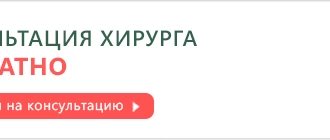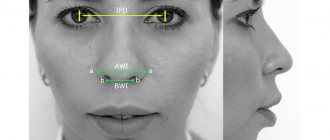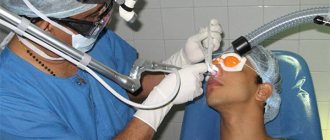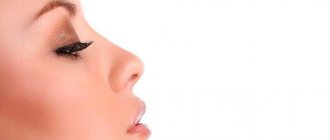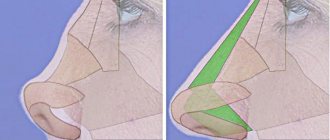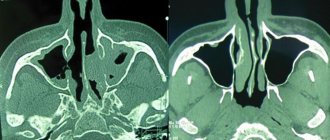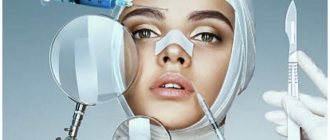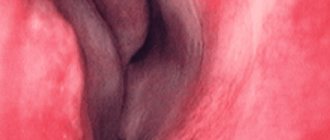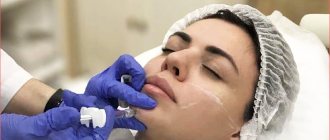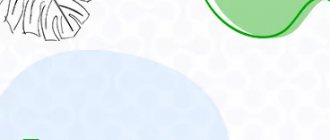What it is?
Septoplasty is an operation to correct defects and deformations of the osteochondral wall (nasal septum), dividing the nasal cavity into the left and right parts.
When the nasal septum is deviated, it moves to one side (usually to the left). Because of this, nasal breathing and the release of mucus from the sinuses are disrupted. Possible causes of a deviated nasal septum:
- physiological - sometimes a deviated septum occurs during fetal development or is caused by a hereditary predisposition
- traumatic - injuries to the face and skull can cause displacement of the nasal septum;
- The natural aging process can affect the curvature of the septum, in some cases this can lead to nasal obstruction.
Moreover, in infants such trauma can occur during childbirth.
Children and adults can suffer injuries that affect the curvature of the septum as a result of an accident. For example, during sports, rough games. Important! Deterioration of nasal breathing due to nasal curvature contributes to chronic inflammation of the paranasal sinuses, middle ear, bronchi and lungs, and impedes the outflow of venous blood from the brain. It is important to perform reconstructive surgery as early as possible in order to prevent the development of infectious complications and oxygen starvation of the body (hypoxia).
Figure 1. Top: Crooked nasal plate. Bottom: The same, but after surgery. Source: Mayo Foundation for Medical Education and Research
Causes of curvature
Deformation can be caused by:
- congenital anomalies - abnormal development of the facial skeleton;
- mechanical injuries (impacts, falls);
- mechanical impact of hypertrophied tissue in adenoiditis, polyposis, hypertrophic rhinitis, rhinosinusitis;
- uneven growth of cartilage and bone during puberty, due to which the rapidly growing cartilaginous part of the septum begins to bend;
- pathological growth of the vomeronasal rudiment.
Indications
In mild cases, when the deformation of the septum does not interfere with the movement of air, surgery is not indicated. Surgical correction is necessary if:
- breathing through the nose is so impaired that the quality of life suffers;
- sinusitis (inflammation of the mucous membranes of the paranasal sinuses) recurs;
- frequent nosebleeds;
- significant cosmetic defect;
- pronounced snoring.
Figure 2. On the left is a deviated septum.
On the right - healed, after surgery. Source: houstonadvancedsinus.com Sometimes septoplasty is performed as a stage of a complex operation to correct maxillofacial malformations (cleft palate or cleft lip).
Postoperative care and observation
- — in a hospital, postoperative care includes, first of all, the regime and observation by a doctor of the healing process. The patient does not perform any actions independently without the recommendation of the surgeon.
- — after discharge from the hospital, the patient spends the first week at home. It is recommended to maintain a home regime, avoid increased physical activity, crowded places, and follow the recommendations. Often, nasal rinsing with large volumes of saline solution, up to 1 liter (Dolphin, Aqua-Maris, etc.) is prescribed.
- — after returning to work, the patient must gradually enter the natural rhythm of life, slowly increasing physical activity to the usual level. Significant, exhausting loads, visits to the pool, baths, saunas, exercise in the gym, flights, business trips are recommended to be postponed for 1 month after the operation for normal recovery of the body. Often, the surgeon will schedule a follow-up examination 2-4 weeks after surgery to monitor the recovery process.
Contraindications to septoplasty:
- coagulopathies (insufficient blood clotting with increased bleeding);
- chronic liver and kidney diseases;
- infections in the active stage;
- allergy to anesthetics;
- somatic diseases in the stage of decompensation (diabetes, heart disease, etc.).
Important! Since the septum is the “centre of growth” of the nose, correction of its shape is not recommended for girls under 16, and for boys under 17–18 years old. In these cases, surgery is performed only for emergency reasons, for example, after a nasal injury or to correct developmental abnormalities.
Rehabilitation
The rehabilitation phase after submucosal resection is critical. Following recommendations from doctors reduces the overall duration of the postoperative period, speeds up healing, reduces the discomfort of the recovery stage, and helps to avoid complications.
It is important to maintain proper nasal care. At first, you should absolutely not blow your nose and try to prevent sneezing. These actions can provoke perforation of the mucous membrane. You can clean the nasal passages using rinsing or auxiliary items (wet wipes, cotton swabs).
During the active recovery period (approximately 3 months), do not wear glasses to avoid pressure on the bridge of the nose, engage in intense physical activity, be exposed to ultraviolet radiation, take hot baths, or sleep on your side or stomach.
What types of surgery are there?
There are two options for nasal septum correction: the traditional open method and the endoscopic method. The first involves direct access to the osteochondral wall through the nostrils. The second allows you to visualize the surgical field in all details using an optical device - a rigid endoscope. Such operations are performed quickly, and the risk of postoperative complications is negligible.
Types of septoplasty:
- The traditional open method (submucosal resection of the nasal septum) involves direct access to the osteochondral wall through the nostrils.
- Endoscopic method - allows you to visualize the surgical field in all details using an optical device - a rigid endoscope. Such operations are performed quickly, and the risk of postoperative complications is negligible.
Surgery to correct the nasal septum
Correction of a deviated nasal septum is carried out only surgically. The operations are called septoplasty or submucosal resection of the nasal septum. Septoplasty - what is it? Sometimes this type of operation is combined with correction of the external nose and is part of rhinoseptoplasty. Before and after photos will help you understand more clearly what nasal septoplasty looks like.
It is important to understand that operations are carried out to eliminate functionally significant disorders, that is, leading to the development of pathologies that cause complaints in the patient or hidden problems in his body. Minor deviations of the nasal septum that do not cause problems with nasal breathing or contribute to the development of other pathologies are usually not subject to surgical correction.
Normal nasal septum - minor curvatures Smooth septum after septoplasty
The purpose and course of the operation is to highlight the curved bone and cartilaginous structures of the nasal septum, partially remove it, and straighten the remaining part as much as possible, while preserving the mucous membrane covering the nasal septum, leaving intact or restoring the supporting parts of the nasal septum. Access is through the patient's nostrils. There are no external incisions, so the operation leaves no visible scars. Septoplasty of the nasal septum does not change the external shape of the nose, so this intervention is invisible to others.
To perform the operation, predominantly a “cold” instrument (scalpel, etc.) is used. Laser and radio frequency technologies popularized among the masses are auxiliary.
They are used primarily for correcting nasal turbinates, sometimes making incisions in the nasal septum or working with cartilage, and stopping bleeding. In the vast majority of cases, complete correction of the nasal septum requires work with bone structures, where laser or other destructive-coagulation technology has no advantage. Nevertheless, we often encounter patients who insist on laser correction of the nasal septum, fully confident that this is the only modern method, and a cold instrument is a thing of the past. Unfortunately, this is not so, one might even say the opposite. Possessing excellent hemostatic (hemostatic) properties due to high temperature exposure, the laser burns or “welds” tissue and still cannot come close to a well-sharpened scalpel in terms of cleanliness of the incision and healing time. The world's leading clinics “still” use classical instruments when working on the nasal septum, and their standards do not include the mandatory use of a laser during surgery on the nasal septum. But in defense of the laser, we can say that it is very convenient for operations on the nasal turbinates due to its hemostatic effect, although there are many other techniques that are no less effective, such as electrical and thermal effects (including cryocoagulation, popular in Russia), and the use of ultrasound , radiofrequency methods of surgery.
There are techniques for operating on the nasal septum using a special video camera - an endoscope, which is also an option rather than a necessity.
The choice of additional equipment during surgery (endoscope, laser, radiofrequency coagulator) falls entirely on the shoulders of the specialist, not the patient. An incorrectly or inappropriately used instrument will not only not help, but will also complicate the operation. Only the surgeon knows how much this or that instrument will help him in performing the operation.
Almost always, surgery on the nasal septum (before and after photos) is combined with simultaneous correction of other intranasal structures - the turbinates.
These formations of the nasal cavity greatly affect nasal breathing, and their improper functioning can lead to the development of the pathology “Vasomotor rhinitis”. With a deviated nasal septum, the nasal turbinates often take the shape of its curvature and become asymmetrical. In this case, even with their normal functioning without correction, it is difficult to achieve good nasal breathing only through surgery on the nasal septum. Since one-time correction of the nasal turbinates and nasal septum is used everywhere, doctors often talk about correction of the nasal septum, meaning one-step correction of these structures as well. In some institutions, work with the nasal turbinates is immediately included in the cost of the operation, while in others it may be a separate item. But it is still inseparable from surgery on the nasal septum to restore good nasal breathing.
How does the nasal septum correction process work?
This surgical intervention is performed in the ENT department as planned: after the examination, the patient is admitted to the hospital. The procedure takes about an hour. If the postoperative period is calm, you can return home the next day and undergo recovery on an outpatient basis.
Photo: Archives of plastic surgery / Open-i (Attribution-NonCommercial 3.0 Unported)
How to prepare for surgery
- 2 weeks in advance, stop taking medications that affect blood clotting - anticoagulants (Aspirin, ThromboASS, Acetylsalicylic acid, etc.) It is necessary to consult your doctor before stopping anticoagulants. If the medications cannot be discontinued, notify the surgeon about this and talk to the attending physician about a possible change in therapy.
- in the presence of concomitant diseases (coronary artery disease, hypertension, bronchial asthma, peptic ulcer, etc.), consult with your doctor about the possibility of surgery and the need for preoperative preparation.
- 2 weeks before surgery it is advisable to stop smoking and not drink alcohol
- for women - stop taking hormonal contraceptives 1 month before surgery or consult a gynecologist. This is especially important if you have varicose veins.
- If you have severe dry nose, then 2-4 weeks before surgery you should consult with the operating ENT surgeon. Dry mucous membranes and significant crusts can adversely affect the operation and postoperative period.
Diagnostics
An ENT doctor may detect a deviated septum during an examination. Bright light and a nasal speculum are usually sufficient to make the diagnosis. If concomitant pathology of the nasal structures is suspected, a computed tomography scan is prescribed.
Before the operation, the following examinations will be prescribed:
- clinical and biochemical blood tests;
- chest x-ray (especially important for patients over 45 years of age, smokers, and those with heart or lung disease);
- electrocardiogram.
Cost of treatment
The complex cost of treatment for a deviated nasal septum (septoplasty in St. Petersburg) ranges from 65,000 rubles. up to 78,000 rub.
Depends mainly on the comfort of the room and the length of stay in the hospital.
You must understand that the final price does not consist of the cost of the operation itself (which is 17,500 rubles), but of the prices for all services provided during the treatment process: surgery on the nasal septum and nasal turbinates, anesthesia, hospital stay, doctor’s manipulations and nurses. In the presence of concomitant pathology, such as chronic sinusitis (sinusitis), neoplasms of the paranasal sinuses (cysts, polyps), the cost increases when eliminating this pathology.
Click the "Submit" button. Find our request for patient personal data and medical documents in your email. Answer all questions in the questionnaire and add your own questions. How to prepare medical documents for preliminary analysis: - create a folder in cloud.mail.ru (or in any other storage, ...) - upload medical document files there (scans, photos, archive), - copy the link to the folder in the cloud , - insert the link into the letter with the questionnaire. Please note: one patient - one letter. Your letter is analyzed by an active surgeon (and, if necessary, a council of specialists) in his free time from his main job. Thank you for your attentiveness to the instructions and clarity of wording. There are still questions
Researcher, ENT surgeon of the highest category, Ph.D. Sergey Alekseevich Eremin.
Possible complications:
Photo: Allergy & rhinology (Providence, RI) / Open-i (Attribution-NonCommercial-NoDerivs 3.0 Unported)
- uncontrolled bleeding;
- infection;
- perforation of the septum;
- changing the shape of the nose;
- impaired sense of smell;
- temporary numbness of the gums of the upper dentition;
- hemorrhage under the mucous membrane of the septum.
How is rehabilitation after septoplasty?
With the development of technology, septoplasty has ceased to be uncomfortable. The operation begins with the patient being given anesthesia, then the doctor uses an endoscope, through a small incision, to enter between the layers of the mucous membrane and straighten the septum.
During the rehabilitation period, technologies were also created that allow the patient to avoid unpleasant sensations and breathe through the nose. Intranasal septal splints according to Reiter or splints were created. They are made of soft silicone, as it does not cause any harm to the nasal cavity and is painlessly removed from it. The splints have a seven-sided shape, which completely follows the shape of the nasal septum at the site of the operation. The essence of splints is that they keep the septum in the midline. After the operation, while the patient is under anesthesia, a silicone splint is sewn on.
Splints come in different modifications. Depending on the shape of the nose, they can be either large or small. A tube can also be inserted between the silicone of the splint, through which the patient can breathe immediately after the operation. The septal splint stays in the nose for about 5-7 days, during which time the nasal septum takes its position.
Benefits of treatment under compulsory medical insurance
Surgical correction of curvature is an expensive surgical procedure.
But with a compulsory medical insurance policy, you can restore your health and save good money. The state cares about the right of citizens to free medical care, provides financing, so there is no need to pay again. Despite the well-established opinion that it is impossible to get quality treatment without money, you need to demand an appropriate attitude. In fact, the treatment of the insured is already paid for in the form of taxes from wages. And the insurance company that issued the compulsory medical insurance policy will help you sort out all controversial issues.
